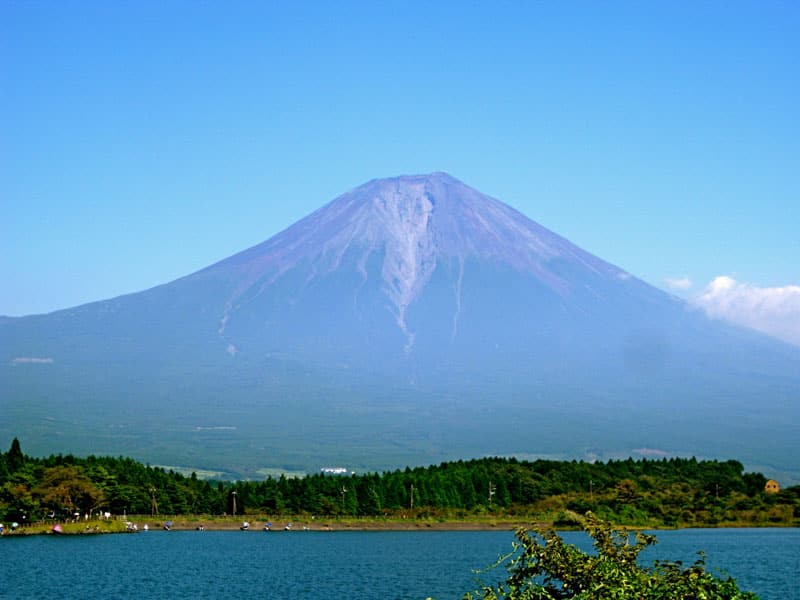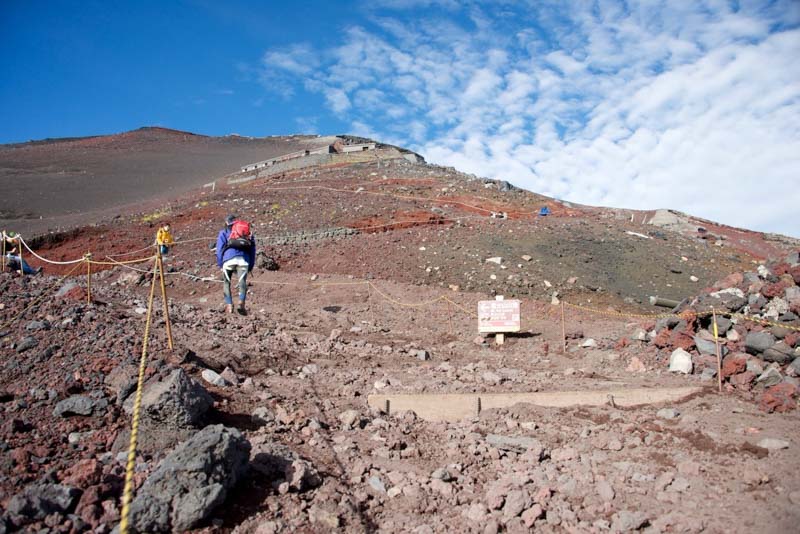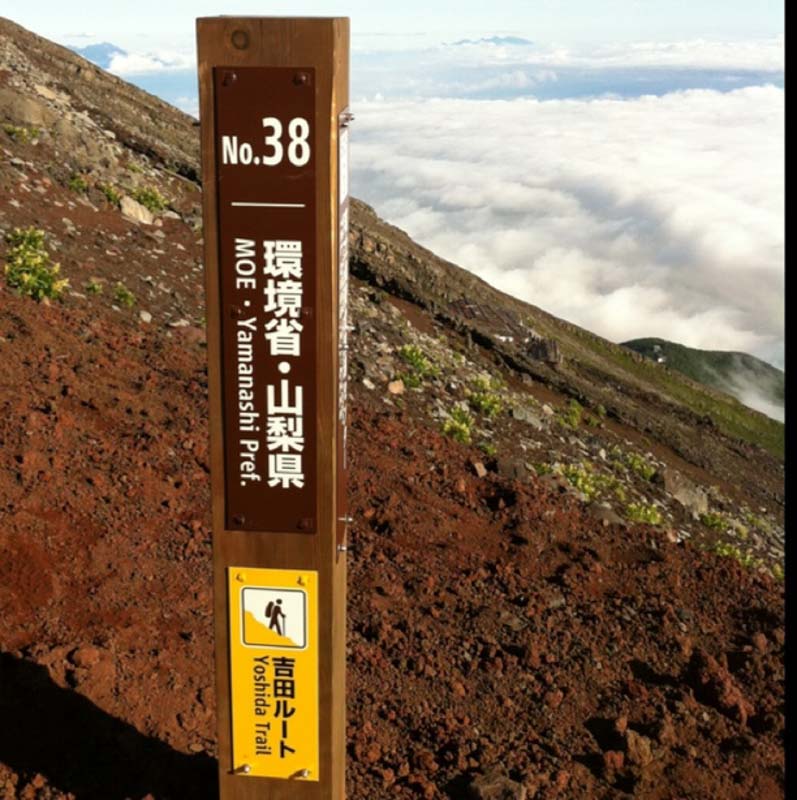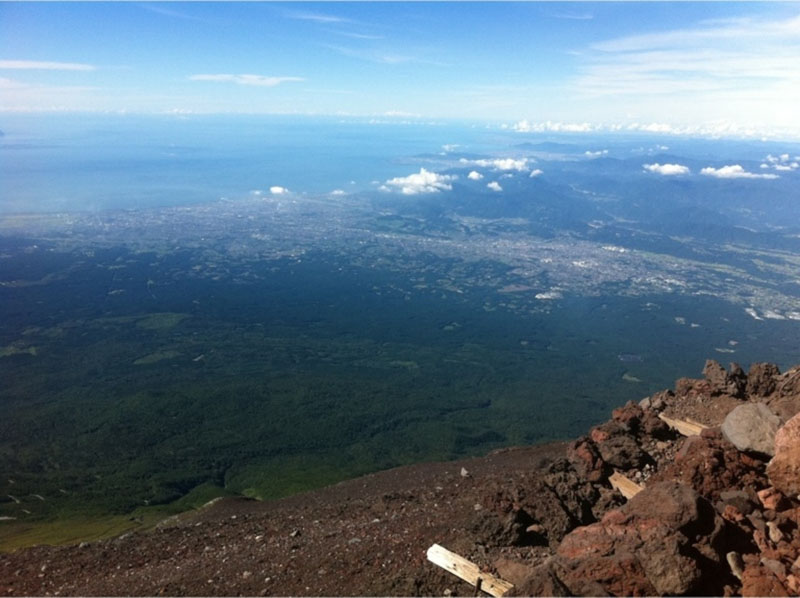Hiker’s Guide to Climbing Mount Fuji
By Explorer Gillian Birch –
According to an ancient Japanese proverb, ‘He who does not climb Mount Fuji is a fool, but he who climbs Mount Fuji twice is also a fool’. For many people, climbing Mount Fuji is a rite of passage and around 200,000 people take on the challenge each summer. Standing at 3776 metres in elevation, this active volcano is Japan’s highest and most sacred mountain. Here are the key points for anyone planning to make this epic hike.
Mount Fuji Climbing Festival
The official season for climbing Mount Fuji starts on 1st July each year. The short hiking season closes around 10th September on the Shizuoka side and on 14th September on the Yamanashi side. The opening of the season is marked by the Mount Fuji Climbing Festival, with a ceremony hosted at Kanatorii Park in Fukiyoshida on the last day of June.
Fujiko priests perform a traditional Shinto ritual at the Kana-torii gate of Mount Fuji. After a speech by the mayor of Fukiyoshida, you can join in the procession of priests and hikers carrying walking poles and flags. They parade up to the Kitaguchi Hongu Fuji Sengen Shrine, where the official opening of the Yoshida Trail takes place with a ceremonial rope cutting.
[button style=’blue’ url=’https://www.expedia.com.sg/things-to-do/mount-fuji-full-day-tour-with-cruise-lunch-by-japan-oriental.a246763.activity-details?srp=true&location=Fuji,%20Japan’ icon=’entypo-book-open’ fullwidth=’true’] Book a Mount Fuji Full Day Tour[/button]
Getting to Mount Fuji

Mount Fuji is easy to reach from Tokyo by car or local transport. Located about 100 kilometres southwest of Japan’s capital city, the mountain is divided into 10 stations, ranging from Station 1 at the base, to Station 10 at its peak. Trains connecting with mountain bus services run to four different points at Station 5, approximately halfway up the mountain.
The most popular location to start your climb is the Fuji Subaru Line 5th Station. Situated halfway up the Yoshida Trail, it has far-reaching views of the Fuji Five Lakes area below. The station is well developed with coin lockers, restaurants and shops for stocking up on last-minute supplies. From this point, allow five to seven hours for the ascent and three to five hours for the descent.
Other starting points at this 5th level include the Subashiri 5th station at the base of the Subashiri Trail (a five to eight-hour ascent) or the Gotemba 5th Station on the Gotemba Trail (a seven to 10-hour ascent). The Fujinomiya 5th Station, closest to the summit, offers a four to seven-hour ascent via the Fujinomiya Trail.
What to Expect

No climbing skills are required to climb Mount Fuji during the official climbing season, but adventurers will encounter some steep and rocky sections on unpaved terrain. The biggest challenge is that the climb is strenuous and the higher you climb, the thinner the air becomes.
Many climbers suffer from altitude sickness symptoms, which may include headaches, dizziness and nausea. The best way to avoid it is by staying hydrated, maintaining a slow pace and taking frequent breaks. Using bottled oxygen can also help in the rarefied atmosphere.
Other hazards of climbing Mount Fuji include poor visibility due to low clouds, falling rocks, sudden wind gusts, rain showers and exposure to the sun. Outside the official climbing season, climbers need suitable clothing and full climbing apparatus to combat the mountain’s freezing temperatures, high winds, snow and ice.
On the plus side, the camaraderie with fellow climbers and the sense of achievement at reaching the top of Mount Fuji are elating. You may want to prolong your moment of glory by hiking around the crater rim, which takes about an hour. With free Wi-Fi services at the summit, you can even send texts and images of your victory to family and friends around the world.
How Long Does it Take
Most climbers choose to climb Mount Fuji over two days, aiming to reach the summit around sunrise when the view is at its best. The best way to achieve this is to climb to the 7th or 8th Station on the first day. Make use of a mountain hut to eat and sleep before rising early to complete the climb.

The Yoshida Trail has more than a dozen mountain huts providing meals, beds, toilets and supplies between the 7th and 8th Stations. Expect to pay around 7000 yen (about SG$77) for a night’s stay with dinner and breakfast included. You can also buy canned oxygen at the mountain huts for the final push and you can have your hiking stick branded – a unique bragging right to prove your achievement to sceptical family and friends.
How to Prepare for Your Mount Fuji Ascent
 Being correctly equipped to climb Mount Fuji is essential to your safety and success. Wear proper hiking shoes to protect your ankles on the loose, uneven terrain. Pack gloves and layered clothing suitable for the freezing temperatures, strong winds and rain you are likely to encounter.
Being correctly equipped to climb Mount Fuji is essential to your safety and success. Wear proper hiking shoes to protect your ankles on the loose, uneven terrain. Pack gloves and layered clothing suitable for the freezing temperatures, strong winds and rain you are likely to encounter.
A headlamp is essential for pre-dawn climbing and leaves your hands free for scrambling up the steep sections. Hiking sticks can be purchased at most 5th Stations and may prove useful for the descent. Water and food supplies are necessary, although you can top up at the mountain huts. You’ll also need some cash to pay for meals, toilets, oxygen, daytime use of rest stations and overnight lodgings. In addition, every climber is asked to contribute 1000 yen at the trailhead to contribute to the supporting services and maintenance of the trail.
Not much of a hiker yourself? You can book a leisurely Mount Fuji full day tour instead. Or combine a few attractions in one with this tour that takes you to Mount Fuji, Lake Ashi and Hakone National Park by Bullet train.
[button style=’blue’ url=’https://www.expedia.com.sg/things-to-do/?location=Fuji,%20Japan’ icon=’entypo-lifebuoy’ fullwidth=’true’]More Tours and Things to do in Tokyo near Mount Fuji[/button]
[tabs title= Useful Info]
[tab title=”Best Time to Visit” icon=”entypo-light-up”]Plan your trip during the official climbing season, between 1st July and early September on the Shizuoka side (Subashiri, Gotemba and Fujinomiya Trails) or mid-September on the Yamanashi side (Yoshida Trail). It’s particularly special to attend the Mount Fuji Climbing Festival on 30th June. Avoid school holidays (20th July to late August) when the trails are particularly congested.[/tab]
[tab title=”Where to Stay near Mount Fuji” icon=”entypo-suitcase”]There are a range of hotels and places to stay near Mount Fuji, providing easy access to the mountain trails.
Popular hotels near Mount Fuji include Hyatt Regency Hakone Resort and Spa, Highland Resort and Spa and B&B Pensione Hakone [/tab]
[tab title=”Getting There” icon=”entypo-address”]
Cheap flights to Tokyo’s Haneda International Airport (HND) from Singapore are provided by Air Asia, Korean Air, China Eastern and other leading airlines.
Mount Fuji is easy to reach from Tokyo Airport by car or local transport. The mountain can be reached via 10 different stations, Station 1 at the base to Station 10 at the peak. Trains connecting with mountain bus services run to four different points at Station 5.[/tab]
[button icon=’entypo-docs’][/button]
[tab title=”Visa Requirements” icon=”entypo-vcard”]A visa is not required for Singapore citizens visiting Japan for trips of up to 90 days.[/tab]
[/tabs]
More Articles With Active and Adventure
Thrill seekers take note, these pulse-quickening adventures will inspire conversation fodder for years to come—as well as plenty of amazing photos for your Instagram.